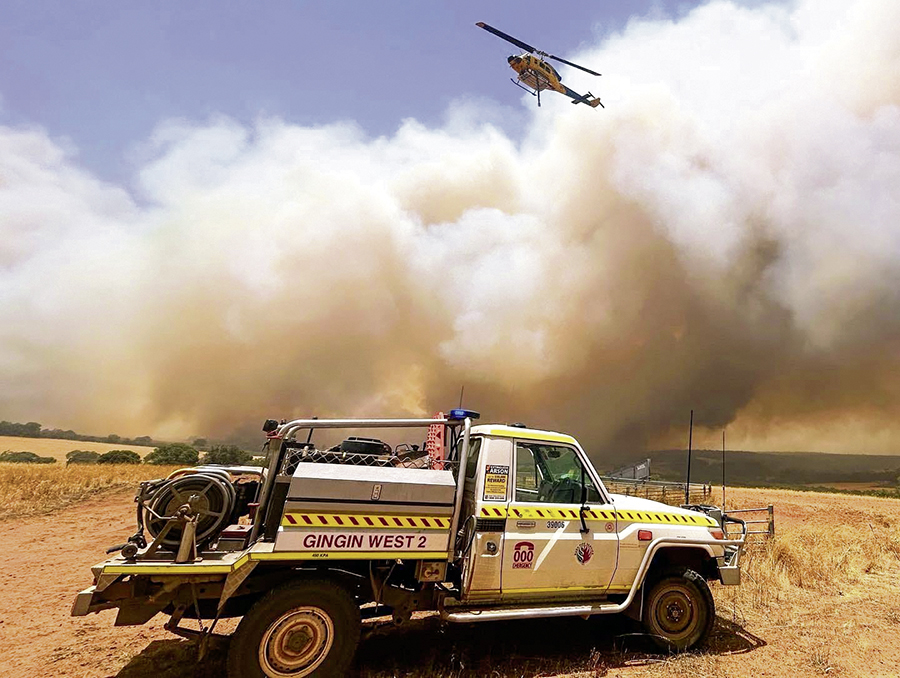When I first visited Tony and Jenny Maddern’s Avalon Farm for a cover story in August 2021, I found it remarkable how lush, fertile, and green the property was, and could visualise how beautiful the Jacaranda-lined driveway must look later in the year when in bloom.
Now, it is nearly unrecognisable. The Bindoon-Chittering fire which started on Saturday 13 January has severely impacted the property, with passionfruit and citrus trees completely gone, a third of the avocado trees lost, and 80% of their mango trees —laden with fruit due to picked about now — burnt or scorched.
Fortunately, their house was saved — but you could not have got a closer call. From the kitchen window you can see burnt grapes dangling from the verandah, and scorch marks on the floor where the fire was brought to a halt by firefighters.

When the fire broke out Tony, “Went up to the hill right up the back of our place, and there’d been a wind shift and it started burning back onto itself. I thought, oh, this is good, we will be right.
“Sunday morning, I went up there and it was a different story. The easterlies had come in and it was blowing straight towards us, barrelling across the grassland. When it came within a few hundred metres of the house, we called it and left — there was no way to defend it.”
While seeking shelter at the evacuation centre at Granville Civic Centre, Tony and Jenny received — thankfully false — reports that their house had gone. However, it was a tense few hours before Tony could return and see for himself that the house was still standing.
“I think the firies thought there’s no hope that this house will survive — a wooden house surrounded by trees,” explains Tony. “But there was a couple of them, Paul and John Fewster, and Paul Brocklehurst who decided they’d come and have a look and they saved it.
“It was a magnificent effort. Absolutely magnificent.”

With the initial danger passed, the Madderns returned to the property and were joined by two of their sons, spending the night extinguishing spot fires and assessing the damage in the daylight.
Despite an unenviable to-do list and the future viability of their farm in question, Tony and Jenny are showing a unique kind of resilience, borne of living through other large-scale disasters — not one, but three floods in Katherine in the Northern Territory, and a shipwreck!
“The shipwreck was not us personally!” Jenny is quick to point out — “We had put all our wedding presents on the ship to go up to where we were living in New Guinea and the ship hit a reef and sank — we lost it all.”
In addition to the grand scale repair jobs, clean up is extensive. Clothes and soft furnishings are penetrated with smoke, and ash has settled on most surfaces. When you consider extended power outages and the loss of water supply equipment —“We had five days of bathing out of buckets,” says Tony — even a load of washing seems out of reach.
“You just accept the long road ahead. There’s years of work here to do to get things back to what they were,” said Jenny. “It’s one of those things that you just have to go slowly with because the job is so enormous. You just have to prioritise and work through the process.”
Jenny also emphasises the need to have a bushfire management plan. “Even if you don’t write it down, have a plan in your mind of what you’re going to take. There’s all the practical things – the insurance file, passports, computer etc. I also think you need to take a few things that are precious to you, that might not be practical.
“Put in a change of clothes or two, and a towel and some sheets. You have to think, ‘I’m going to come back and there’ll be nothing but ash.’ Your life will be what you have in the car.”
According to Shire of Gingin President Wayne Fewster 5,500 hectares were burnt in this incident, and two houses and nine outbuildings were lost. However, thanks to an outstanding effort by many individuals and agencies, 54 homes —including Tony and Jenny’s — were saved.

“The heroic efforts of the firefighters has to be accentuated,” said Tony. “We’re eternally grateful to them.”








